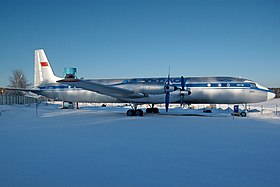Aircraft accident of the Ilyushin Il-18 CCCP-75732 of Aeroflot
| Aircraft accident of the Ilyushin Il-18 CCCP-75732 of Aeroflot | |
|---|---|
|
An Aeroflot Il-18 |
|
| Accident summary | |
| Accident type | Emergency landing on the ice |
| place | In Jemlinskaya Bay, Shelikhov Bay |
| date | February 26, 1963 |
| Fatalities | 10 |
| Survivors | 0 |
| Aircraft | |
| Aircraft type | Ilyushin Il-18 W. |
| operator | Aeroflot |
| Mark | CCCP-75732 |
| Departure airport | Mys Schmidta Airport |
| Stopover | Ugolny Airport |
| Destination airport | Magadan Airport |
| Passengers | 2 |
| crew | 8th |
| Lists of aviation accidents | |
On February 26, 1963, the Ilyushin Il-18 CCCP-75732 of Aeroflot crashed on a cargo flight from Mys Schmidta via Anadyr to Magadan , killing all 10 occupants.
Airplane and occupants
The aircraft was a 3 year old Ilyushin Il-18W ( aircraft registration number : CCCP-75732, serial number : 181002601), which had completed 2105 hours of operation before the accident.
The crew consisted of the flight captain Arkadi Danilowitsch, the first officer PP Sawin, the flight engineer Nikifor Ivanovich Kupryakov, the navigator Radi W. Robinson, who had already worked as a researcher in the Antarctic , the radio operator Ivan Ivanovich Murik and 3 flight attendants. In addition, 2 people flew as passengers.
course
All times in Moscow time specified
The plane took off from Mys Schmidta at 2:29 a.m. and landed in Anadyr at 3:38 a.m. During the stopover there without refueling, 10 tons of meat were loaded in the hold, whereupon the Il-18 took off again at 6:25 a.m. There were scattered cumulus clouds on the route to Magadan and there was partial snowfall . The visibility was 8-10 kilometers. At 8:14 am, the aircraft flew over Gischiga Airport at 7,000 meters under visual flight rules ; meanwhile the pilots announced the remaining amount of fuel of 9 tons. About half an hour later, at 8:45 am, the pilots asked for clearance to descend in an emergency and reported the failure of engine no. 2. Around this time the aircraft deviated to the left of the planned course and began to accelerate at 17-19 m / s sink. In the following minutes there were several radio reports from the pilots. First came at 8:47:30 am “Иду вдоль береговой черты. Высота 3 000 м. Отказали двигатели с одной стороны "(analogously: fly along the coastline . Altitude 3,000 meters. Failure of the engines on one side), then by" Отказали два двигателя два двигателя нва двигателя с левойор on the left side: two engines on the left side. . At 8:50 a.m. the aircraft turned on a course of 210 ° (southwest) while flying at 2,000 meters. Between 8:52 a.m. and 8:53 a.m., the last radio message came: "Сажусь на вынужденную на море" (meaning: I will make an emergency landing at sea). Another 2 minutes later, the aircraft touched down on the ice of Jemlinskaya Bay on a heading 210 ° with the landing gear retracted , about 1 hour before sunset and 2,700 meters from the coast, whereupon it crashed and sank.
The scene of the accident was found on March 4 at 8:30 a.m., 6 days after the emergency landing. Spread over 2 ice floes 300 meters apart, several small fragments of the aircraft were found, including engine No. 1. The flight engineer Kupryakov, the radio operator Murik, a flight attendant and a passenger made it out of the wreck, but became like them other inmate found dead. Murik drowned while the others made it out of the water onto the ice, but died there of hypothermia in clear weather and an air temperature of −18 ° C.
root cause
The emergency landing on ice could not be reconstructed at first because the aircraft could be steered to the end and, despite the two failed engines with a total mass of 50 tons, no emergency descent was necessary, provided that the propellers were in the sail position . There was no sign of a pressure drop in the aircraft and the pilots were trained enough to properly assess the situation. Landing on land would not have been possible due to the terrain. However, the fact of the emergency landing indicated that an onward flight was not possible; possibly a fire had broken out or the feathering mechanism on one of the engines had failed. It was also found that there was no emergency equipment, including warm clothing, sleeping bags and signaling aids.
Ultimately, the investigators came to the conclusion that hot air was escaping through a leaky line in engine no. This met other lines that were responsible for electrics, fuel supply and the sail position. As a result, engines No. 1 and No. 2 failed, the propellers of which could not be brought into the sail position, but got into what is known as "windmilling"; a fire also broke out.
swell
- Accident report IL-18 CCCP-75732 , Aviation Safety Network , accessed April 3, 2020.
- Description of the accident on airdisaster.ru (Russian), accessed on August 25, 2019
- Description of the accident on avia.pro (Russian), accessed on August 25, 2019
- Article about the accident (Russian) of Moskovsky Komsomolets (with picture from navigator Robinson), accessed on August 25, 2019
